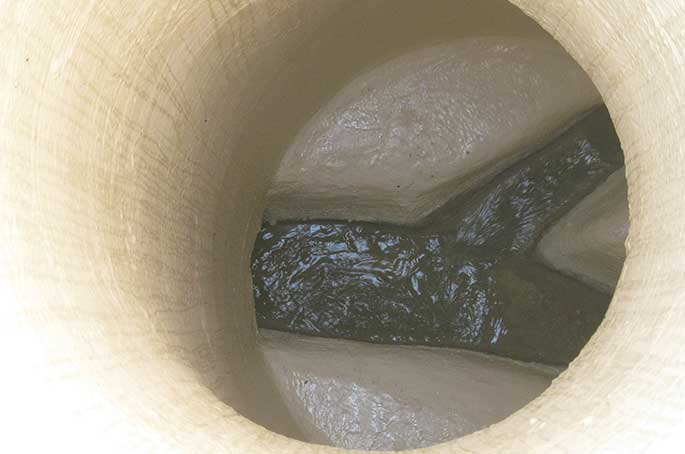May 2017 Vol. 72 No. 5
Features
Do Manhole Rehabilitation Technologies Perform as Expected?

Spending for manhole structure rehabilitation has grown due to increased deterioration and collection system infiltration control. It is important to understand how the manhole structure functions, and how the deterioration and corrosion mechanisms are affecting the structures. Should the structures be replaced or rehabilitated? Should the selected rehabilitation method be bonded to the existing structure or can it provide the protection required without being bonded?
Most manhole structures can be rehabilitated and very seldom need to be replaced in their entirety. Some manhole structure components may be replaced, but the majority of the manhole structure is most likely be rehabilitated.
The selection of the correct technology (or sometimes multiple technologies) will directly relate to its long-term performance under identified conditions. Conditions may include structure deterioration due to old age, chemical corrosion, or continuous leakage of infiltration and inflow into the structure.
Rehabilitation products can include a variety of materials, which can be applied on their own or in combination with other compatible products. Each individual product will have specific characteristics that may allow mechanical bonding to the host structure or will merely provide a solution without mechanically bonding. Some example materials and technologies include cementitious, polymer, cured-in-place, composite, panel liners and premade inserts.
Cementitious is a monolithic cement product applied on the entire structure to stop infiltration, build back wall thickness and replace deteriorated mortar. Calcium aluminates, geopolymers, micro-silica and anti-microbial additives provide protection against acidic environments down to a PH of 3.
Preparation – The host structure must be properly prepared, as recommended by the product manufacturer, before any liner material is applied.
Measurement, testing and inspection:
Before application – test & inspect preparation of host structure.
During application − measure applied thickness.
After application − visually inspect, test material physical properties, test adhesion, vacuum test (if applicable).
Polymer is a material system that is sprayed, spun or troweled onto the entire structure and is unaffected by water vapor pressure, is sufficiently thick to provide a continuous monolithic lining over the entire structure, restores structure integrity, is pin-hole and defect free, stops infiltration, mechanically bonds to the host structure or is designed as stand alone, and protects the structure against corrosion.
Preparation – Extremely important for performance of products designed to mechanically bond to the host structure. Also desirable for stand-alone designs to seal annulus between host structure and the coating, but not as critical for product performance
Measurement, testing and inspection:
Before application – test and inspect preparation of host structure.
During application − measure thickness of epoxies and cementitious products.
After application − visually inspect from inside the structure, test material physical properties, measure thickness (polyurethane’s, polyuria’s), adhesion test, spark test and core test.
Cured-In-Place (CIP) is a pre-made liner or tube fabric saturated with a polymer resin, bonded to the host structure − or designed as a stand-alone liner, not dependent on adhesion − to improve the structural integrity of the manhole. It protects against infiltration and water vapor pressure and should be pin-hole and defect free, and protect against corrosion
Preparation − Pressure washed to manufacturer’s recommended concrete surface profile and cleanliness, all steps removed, voids and defects repaired and leakage stopped.
Measurement, testing and inspection:
Before − inspect preparation.
During – visual inspection.
After – visual inspection, test material physical property, measure thickness (polyurethane, polyuria), adhesion test, spark test.
Additional products and technologies
are available, which may best suit a specific application.
To ensure performance of manhole rehabilitation products, the structure preparation and product application must be observed, inspected, measured, tested and documented in conformance with the contract documents and applicable industry standards.
Manhole measurement, inspection and testing before application:
Visual inspection
Preparation
Inspection
Moisture level limit
Water vapor
transmission
pH levels
Manhole measurement, inspection and testing during application:
Material thickness measurement (epoxy)
Slump test
Cube test
Cylinder test
Manhole measurement, inspection and testing after application:
Visual inspection from inside
structure
Core Thickness/
Leakage Test
Ultrasonic
Thickness Test
Adhesion Test
Spark Test
Vacuum Test
Conclusion
The three most important requirements for a successful coating/lining application begin with:
PREPARATION, preparation, preparation – verified by quality assurance inspection and testing.
Quality application – verified by quality assurance inspection and measurement.
Testing – verified by inspector testing before, during and after application.
Manhole rehabilitation technologies can perform as expected provided that all structure preparation is accomplished as required, material applications follow strict manufacturer’s requirements, and the post application product is verified through inspection and testing.




Comments